How To Read Horse Racing Form
The first thing to consider is - what is horse racing form?
As you might guess, this provides statistics on how a horse has performed in previous races.
Now, whilst your average punter might not pay a huge amount of attention to this information, it can be hugely beneficial.
It provides a lot of information which owners, trainers and even bettors can use to their benefit and can help indicate how a horse may perform in future races.
Horse racing form guides are widely available in racing programs, newspapers, racecards and many online sources.
Where Do You Find The Horse Racing Form?
Anywhere that provides information on horse race meetings will have details of the form of each horse in a race.
How comprehensive that information is will depend on where you look.
Most UK bookies provide a relatively basic level of details including where they finished in their last few races, age, weight etc.
However, the bible of horse racing and horse racing form is undoubtedly the Racing Post. They provide an incredible amount of information to their readers.
What Information Is Provided In Horse Racing Form Guides?
As mentioned, different sources will provide different information. Understanding that information is the key.
Pretty much every racecard will provide the following basic information:
- The horse name
- The number of the horse
- The stall number the horse is in (if stalls are used)
- The silk colours the jockey will be wearing
- The name of the jockey
- The name of the trainer
- The age of the horse
- The weight - the weight of the horse when it starts the race and includes the jockey and any additional weight the handicapper has added
- The age of the horse
- The form of the horse - this can include numbers, letters and symbols
Understanding The Form Information
Any numbers in the horses form simply indicate where it finished in previous races. It is worth noting that this will show as 0 if the horse finished outside of the top 9. So what do the symbols and letters mean?
Below is a comprehensive list of all the terms you might come across when looking at horse racing form:
Form
| F - Fell | PU - Pulled Up |
| R - Refused | S - Slipped Up |
| U - Unseated rider | BD - Brought down by a competitor |
| Slash (/) - A lengthy break between racing seasons | Dash (-) - Separates racing seasons |
Race Types
| Am - Amateur | App - Apprentice |
| Auc - Auction | AW - All Weather |
| Ch - Chase | Cls - Class |
| Cond - NH Conditional | Div - Division |
| Gd - Grade | Gp - Group |
| Hcap - Handicap | Hur or H - Hurdle |
| List - Listed | Mdn - Maiden |
| NHF - National Hunt Flat Race | Nov - Novice |
Gender & Colour
| b - bay | bl - black | ch - chestnut |
| gr - grey | ro - roan | wh - white |
| c - colt | f - filly | g - gelding |
| h - horse | m - mare | r - rig |
Going
| f or fm - firm | g or gd - good | hd - hard |
| hy or hvy - heavy | s or sft - soft | yld - yielding |
Distances
| dist - distance | f - furlong | m - mile |
| y - yards | l - length | nk - neck |
| hd - head | nse - nose | shd - short head |
Headgear
| h - hood | e - eye hood | e/s - eye shield |
| e/c - eye cover | b - blinkers | t - tongue tie |
| v - visor | p - cheek pieces | Ht - Hood & tongue tie |
Other
| BF - beaten favourite last race | Btn - beaten |
| C - course winner previously | CD - course & distance winner previously |
| D - distance winner previously | J - joint favourite of two |
| N/R - non runner | Trainer name 1 or 2 - horses 1st or 2nd race for this trainer |
| RTF% - the % of a trainers horses that have run to form (last 16 days) | OR - certified rating given by the British Horse Racing Authority (BHA) |
| W1 - first run for a horse after wind surgery | W2 - second run for a horse after wind surgery |
Examples Of Horse Racing Form
Let’s take a look at a couple of examples of how horse racing form is displayed at a bookmaker website and on the Racing Post website.
Bet365
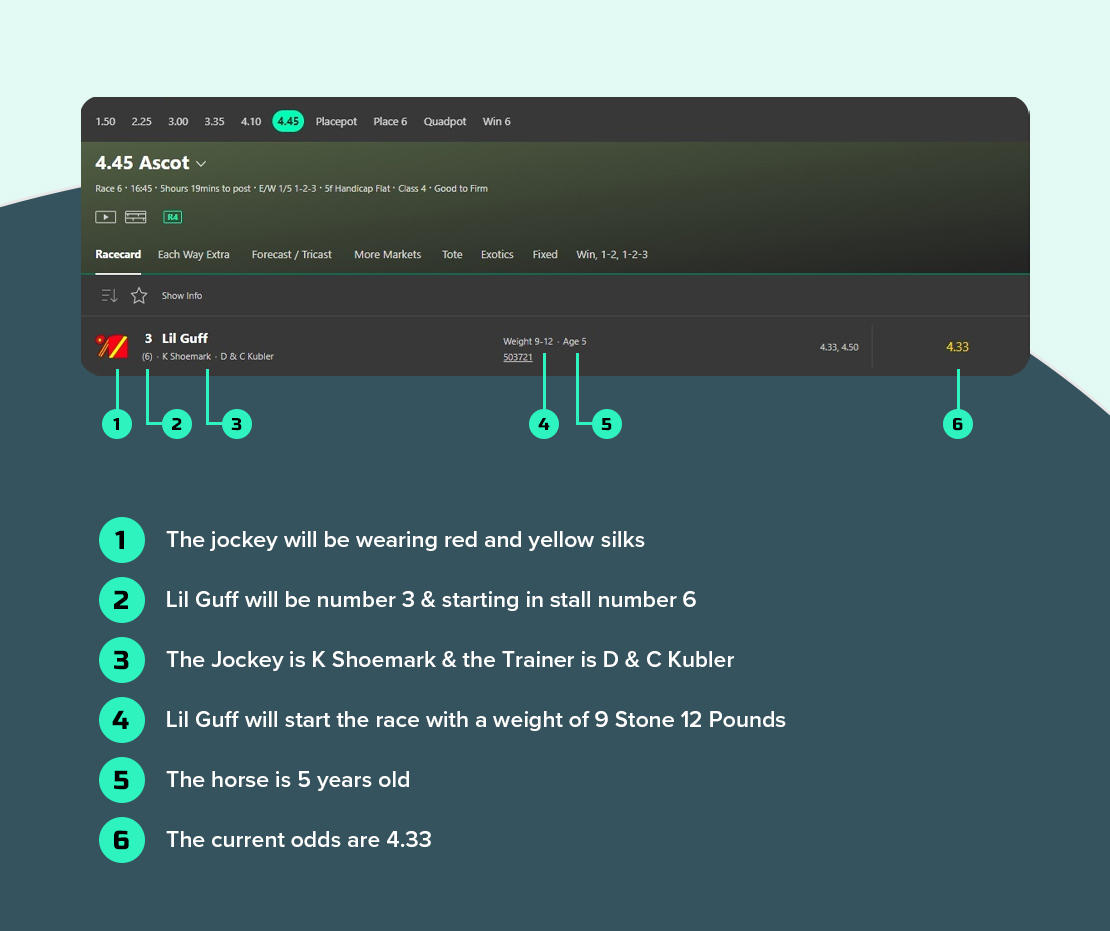
At the top of the racecard, you’re provided with an overview of the race which gives details of how long until the race starts, the E/W terms & places, the race distance and type and finally the expected condition of the race track (good to firm in this case).
Lil Guff - Form
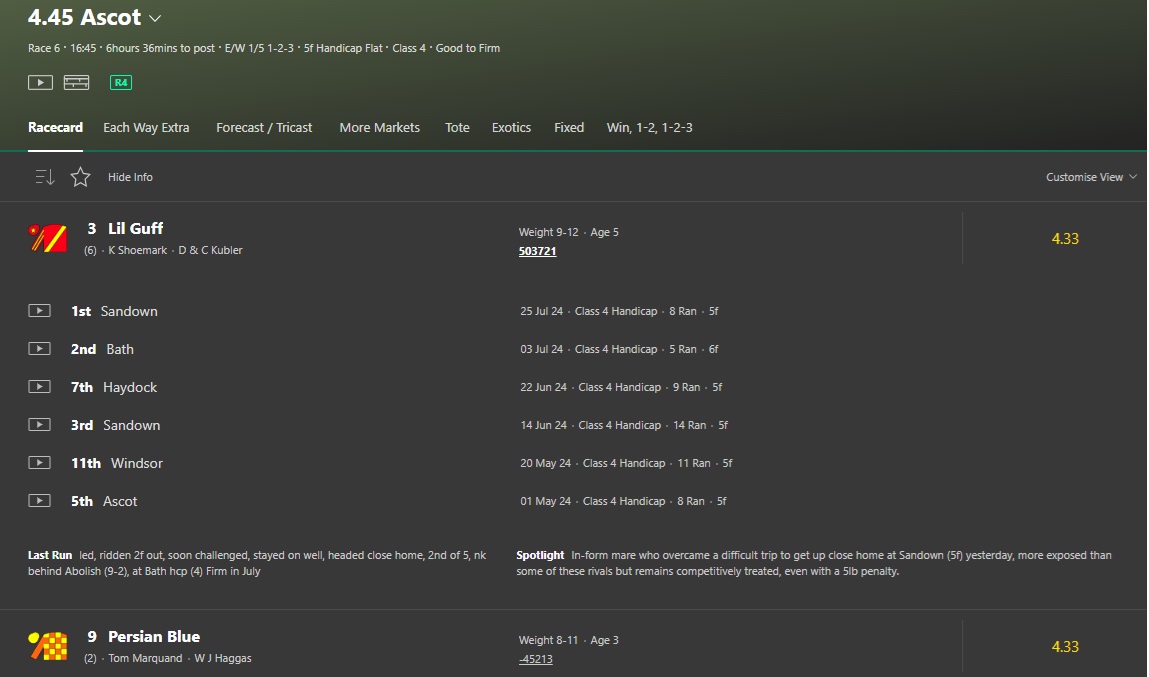
The form is shown underneath the weight details as a series of numbers in white and underlined. If you click on that link (or the horse name) it will reveal the above information.
So the form overview tells you that in her last 6 races Lil Guff has finished 1st, 2nd, 7th, 3rd, 0 (outside the top 9) and 5th.
When you click on the overview link, you can see more information about those previous races such as the date and place of the previous race, the race distance, how many runners there were and the type of race (a bit more about that later).
In addition to this, they also provide more specific information about her last race and a brief overview of Lil Guff and how she might fare in this race.
Now it’s time to move on to the Gold Medal of Horse Racing information suppliers.
Racing Post
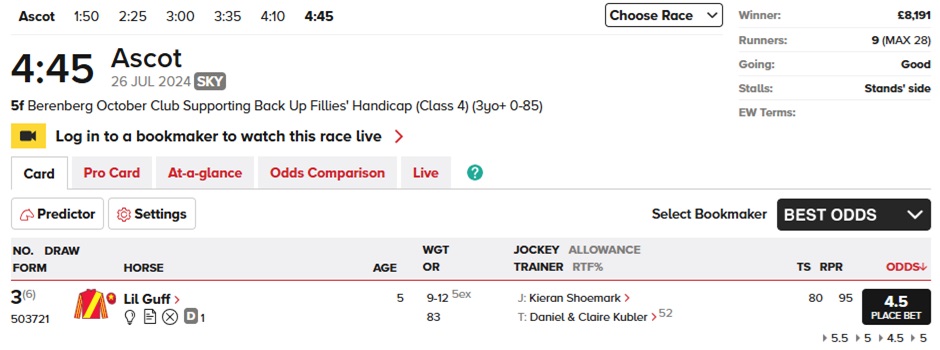
As with Bet365, the summary provides the usual information such as colour silks, Jockey, Trainer, etc.
In addition, you can see the following:
- Winner - The prize money for the winner.
- OR (Official Rating) - This is a rating allocated by the British Horse Racing Authority by Handicappers.
- TS (Top Speed Rating) - After allowances for weight and age, this rating measures performance against the course standard time.
- RTF% (ran-to-form) - This tells you the percentage of horses that have ran to form in the last 16 days for that trainer.
- RPR (Racing Post Ratings) - Exclusive to the Racing Post only, this is calculated to express a horse’s ability compared to the weight they race at. For example, if 2 horses are carrying the same weight but horse A beats horse B, then horse A is given a higher rating. These are given in pounds so a horse with a 130 rating is 10 pounds better than one with a rating of 120.
image.png
- Spotlight - A brief overview of the horse and it’s chances.
image.png
- Form - Expanded details of it’s form in the last few races.
- C, D or CD - This will show if the horse is a previous course Winner, previous distance winner or course and distance winner.
Another feature available on the Racing Post website is a live odds comparison. On the main racecard page, you’ll see a tab that says Odds Comparison. If you click here, you’ll see which bookies are offering the best odds on each horse in the race. It also provides you with details of the E/W terms, which bookies are offering BOG (Best Odds Guaranteed) and what they are offering new customers to join them.
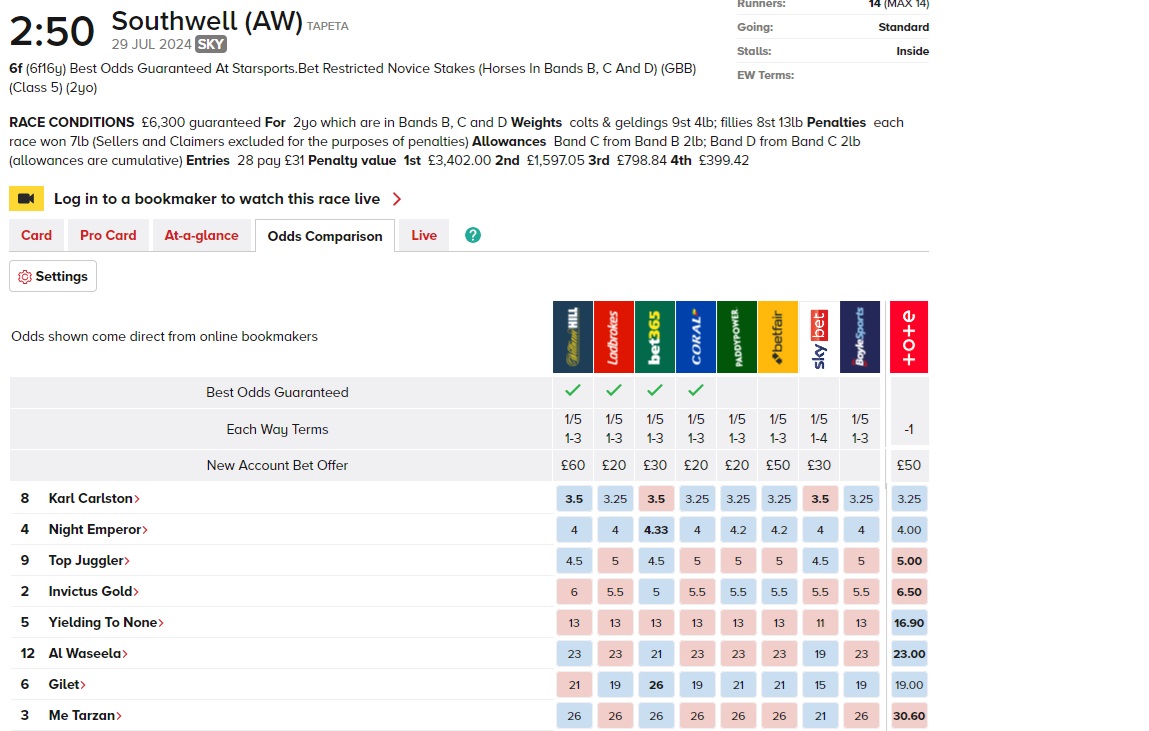
Want To Dig A Little Deeper?
For those of you into your horse racing stats, the Racing Post provides even more information on jockeys, owners and trainers.
Jockey
Do you have a particular liking for one or certain horse racing jockeys? The extra information provided by the Racing Post gives you detailed information about each jockey.
Firstly, you’re provided with an overview of their performance during the last five racing seasons in Great Britain. The drop down list will also allow you to filter on Irish races and the stats for the current year.

Underneath the overview, there are four tabs to get more information.
Form
This shows the last two weeks of races for a jockey.
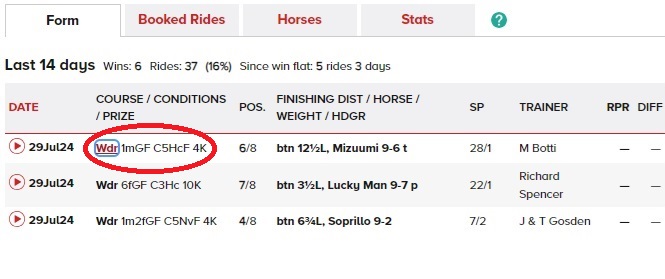
You can see that Kieran Shoemark’s last race was on the 29th July 2024.
The letters and numbers relate to the course Windsor (Wdr), distance (1 mile), conditions (Good to Firm ground), Class 5 handicap for fillies (C5HcF) and the prize was £4,000. He was onboard Mizuumi, finished 6th out of 8 and was beaten by 12.5 lengths.
You can also sort each column in order by clicking at the top of it.
You‘re able to get the same information simply by clicking on the date link and then you’re given a clearer display of the information as below:
Booked Rides
This tab will give you information about what a particular jockey has been booked to ride. Here you’ll see the date, location and time of the races along with the horse they are riding.
Horses
This tab provides information about the horses a jockey has been on during the current year. Again, this can be filtered down to race type and year.
Stats
This tab provides a breakdown of the jockey stats over a longer period including total races, percentage of wins, prize money won etc.
Trainer
As with jockey stats, when you click on a trainer from the racecard, you’re given an overview of the trainers performance from January 2020 to the current date and provides the percentage of their horses that have run to form in the last fortnight. Again, this can be filtered.
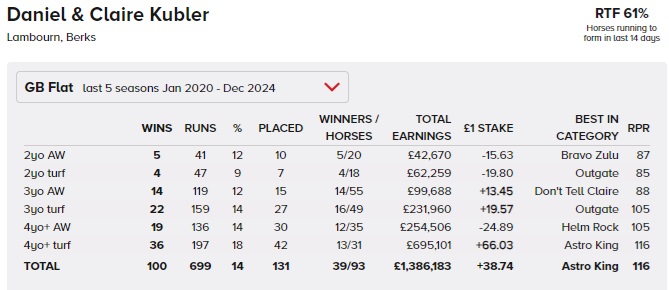
Underneath the trainer summary, you’re provided with various statistics on their form, what horses they have entered into future races, form figures for each of their horses and their yearly figures since 2020.
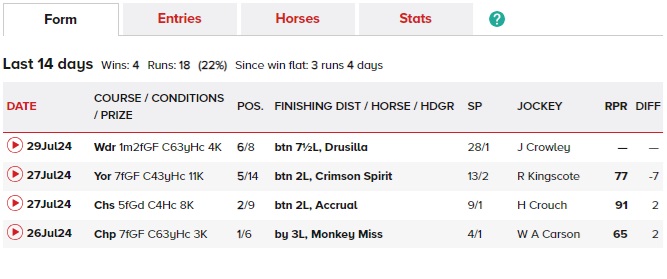
Owner
As you're able to with jockeys and trainers, you can also check out the stats for the horse owners. The below illustrates the details of the owner of lil Guff, Wayne Clifford.
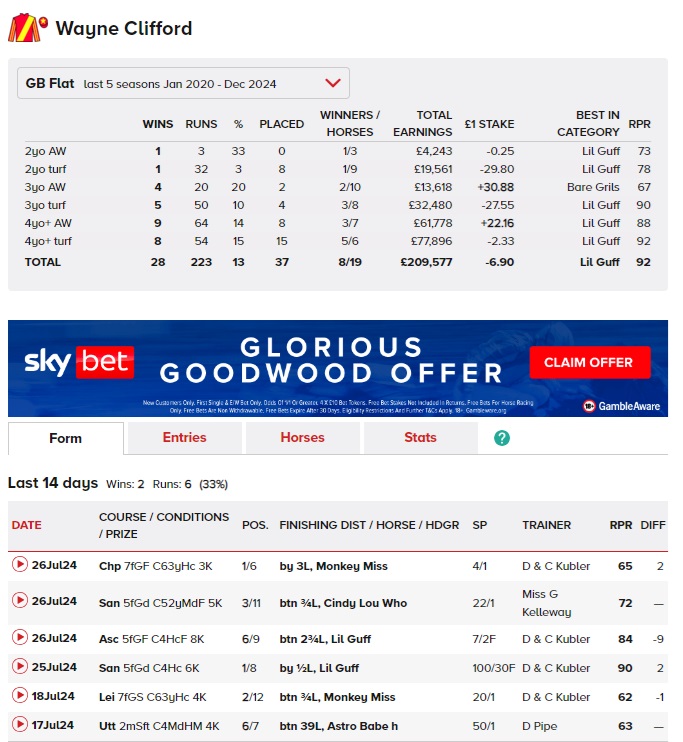
Another source of information worth mentioning is race course details.
If you click on any link for a race course you’ll be provided with information such as scheduled racing events, who the top jockeys and trainers are for that course, a map of the course, course records and more.
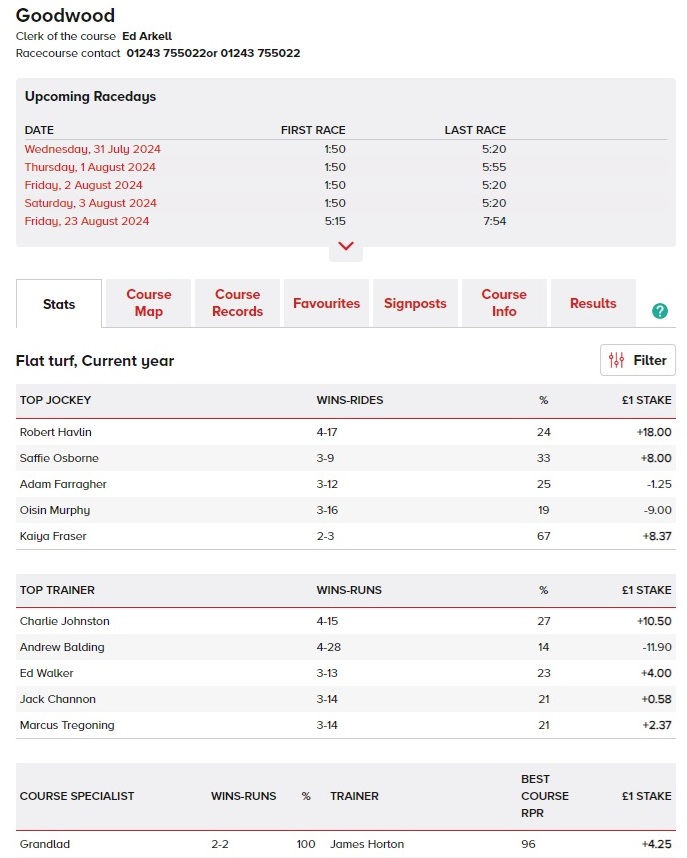
Having covered the information provided on racecards, you'll have seen different types of races and classes.
Horse Racing Classification
As you’ll have seen in the overviews of racecards, there are different classes for horse racing.
With in excess of 16,000 horses on the training circuit, as you can imagine, they all have different abilities.
There are two categories of horse races, flat and jumps.
Flat Races
Group Races - These are the most popular and well known races and are split into three groups - Group 1, 2 and 3. They can then be further categorised by gender (eg mares only) or age groups. These races run throughout the racing year and are spread across different race courses and distances.
- Group 1 - This is where the prize money is at - the highest level of UK horse racing and includes races such as the Oaks, the St Leger, the Gold Cup, 1000 Guineas and 2000 Guineas. All the horses in a Group 1 race run at the same weight irrespective of their OR (Official Rating) to show which horse really is the best. However, there can be small allowances where fillies compete against colts and where 3 year old’s compete against older horses.
- Group 2 & 3 - Whilst a step down from the Group 1 races, these are still extremely significant in the racing world. The Handicappers earn their money in these groups. They have to apply the correct penalties (weight) to each horse in order to make the races competitive. Penalties can be applied to horses that win at an equal or higher level. The main differences between these group races is the standard of horses and the prize money on offer.
Listed Races - These races are one step down from group races and you’ll quite often see horses from group level run in these at the beginning of a season. Listed races can be both handicapped or non-handicapped.
The handicapped races determine a horses weight by the Official Rating (OR) and are then graded into 7 classes, with Class 1 being the highest. The Class system is designed to allow horses to progress through the classes with the aim of getting into group races.
- Class 1 - listed Handicap for horses with a rating of 96-100+
- Class 2 - ratings bands 86-100, 91-105 & 96-110
- Class 3 - ratings bands 76-90 & 81-95
- Class 4 - ratings bands 66-80 & 71-85
- Class 5 - ratings bands 56-70 & 61-75
- Class 6 - ratings bands 46-60 & 51-65
- Class 7 - usually classified stakes racing for ratings 0-45
There are other types of races such as Maidens (where most horses begin) and Nursery (just for two year old horses).
Jump Races - Also known as National Hunt races
Jump races are any race that has obstacles to jump.
The obstacles will either be fences (large) or hurdles (small).
As a rule of thumb, jump horses are usually older (age 3 plus) because jump races require great ability and stamina and have distances of over 2 miles.
They are also normally bigger horses than flat racers.
In addition to National Hunt races, there are races known as conditionals which are limited to less experienced jockeys and amateurs.
Jump races split into five categories:
- National Hunt Flat - also known as bumpers, these races are for horses that have been bred for jumping. These are considered as training races for horses looking to move on to fences or hurdles. As such, there are no obstacles in bumper races.
- Novice Hurdling - Only horses who have not won a hurdles race can compete in these. Should they win a novice hurdling event, they can continue to compete at this level until the end of the current season.
- Hurdling - This is a normal hurdles race and will be competed in grades. Similar to groups in flat racing, horses are entered into grades 1, 2 or 3 with grade 1 being the highest. As with groups, grade one has marginal penalties and the handicaps tend to apply to grades 2 and 3.
- Novice Chasing - The same rules apply to this category as novice hurdling but the race is over fences.
- Chasing - again, very similar to hurdling in terms of grades and handicaps, but run over fences.
Whilst it may seem like there’s a mountain of information with horse racing form, the truth of the matter is that the average sports bettor hardly uses a fraction of it. It’s mainly professionals that need that level of information.
In fact, there are ways Matched Bettors can make money from horse racing without having any knowledge of horse racing form. Check out how with our Extra Place and Horse Racing Refunds guides.
Updated: 8 Dec 2025
The Author
Paul brings over four years of Matched Betting experience to Outplayed. His extensive background in financial services and e-commerce, combined with his expertise in online marketing and Matched Betting, makes him a valuable asset to the team.

